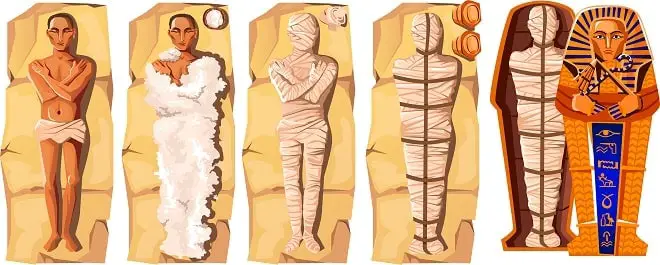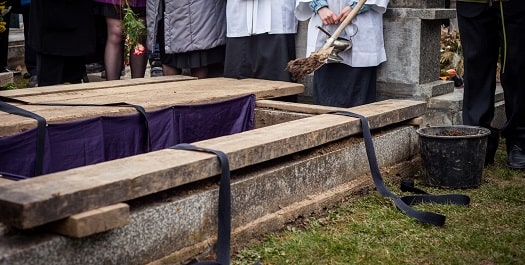There are far too many variables to make an accurate assumption of the time factor it takes for an embalmed body to last within a coffin.
An embalmed body usually lasts in a coffin for up to 10 years, but can last from 3 to 100 years, depending on the:
- Skill of the embalmer
- Length of time from death before embalming
- Size and weight of the body
- Composition of the fluid
- Acidity and moisture of burial ground
- Coffin type
All these factors play a part in the decomposition of an embalmed body.
You may have the misconception that an embalmed body within a coffin will take hundreds of years to break down and return to the earth, but this is not always so.
There are other factors involved that affect the longevity, and some of these include humidity, heat, cold, soil type, availability of oxygen, body weight and size, clothing, and the surface on which the body rests.
Even the type of coffin the deceased is buried in plays a part. Soft timbers such as pine break down more than the hardwood variety.
As a result of these variables, it is almost impossible to give an exact estimate of the time an embalmed corpse will last when buried in a coffin. You could say that it could be from as little as a few years to as much as 100 years or even more.
The Lasting Quality of Embalming
If the deceased is buried six feet down without a coffin in ordinary soil, an un-embalmed adult normally takes 8-12 weeks to decompose to a skeleton.
However, an embalmed body placed in a coffin enables the body to last for many years depending on the type of wood used. An embalmed body can last up to ten years or longer under normal burial circumstances.
But what are normal burial circumstances?
- These include the time between death and the embalming process. The shorter the time, the longer the embalming will last as it seals the body from air, temperature, and moisture.
- The condition of the body also plays a role in the final effect achieved by embalming. Those that have died due to a crash or suffered disease may need more careful embalming especially if the family wants a viewing before the burial.
- The quality of the material of the casket and the lining help to prevent the decay of the body. The harder the material such as metal or hardwood, with thick padded lining within the casket can prevent moisture from seeping into the casket.
- There are several types of chemicals used and they can be used at different strengths which can make a difference to the longevity of the body.
- The skill and care of the embalmer can be the difference from lasting from a few years to lasting for several hundred years.
Famous Examples of Long Lasting Embalmed Bodies

- As mentioned earlier, the most famous of Egypt’s pharaohs, Tutankhamun was embalmed and laid to rest around 1323 BC. His famous sarcophagus are legendary even today.
- The remains of Saint Bernadette were uncovered 30 years after her death in the year 1879. She was found to be incredibly well preserved with little decay or damage.
The reason for embalming is to preserve the body for a certain amount of time, to try to stave off the deterioration of the body.
For the celebrity or great leader, it is a way to remain immortal, to defy death and have their image live on forever.
The Way a Body is Embalmed
Without going into too much detail, the way the body is embalmed is the secret to the longevity of the deceased.
Understanding this process will enable you to understand why the time spent preparing the body is necessary.
- First on the list requires the body to be washed with a disinfectant solution.
- The limbs are massaged to relieve the stiffening of the joints and the muscles so that the body looks relaxed and can be naturally posed.
- With surgical precision, the blood is removed from the body via the veins, and it is replaced with a formaldehyde-based chemical solution which prevents deterioration of the body. The embalming solution may also contain other chemicals such as methanol, ethanol, phenol, glutaraldehyde, and even some dyes to overcome the paleness once the blood has been removed.
- The eyes are secured in a closed position with a special glue, and the lower jaw is secured by wires or sewing. In this way, the face can be manipulated into the desired position.
- Body cavities are filled, and internal organs are drained of gas and fluid contents.
- Once all this is completed, the body can be dressed in the clothes of the family’s choice, their hair is washed and styled, and cosmetics are applied to achieve a near as possible natural appearance.
- At this stage, the body is placed into a casket and prepared for visitation or service.
Visting to view the body can be very helpful to the mourning process. To see the deceased in a calm, almost serene pose can help the family and friends to say goodbye.
The Reasons for Embalming
Preservation is the main reason for embalming, but it can be for an emotional need as well.
- To see the deceased preserved, dressed, and made to look ‘normal’ can ease the grief of losing someone who was a vital part of their life.
- The need to have them looking their best makes the mourner feel better. They feel they have ‘taken care’ of that person’s last rites of passage.
- Many believe that embalming and dressing the body will also protect it from the grave, which sounds morbid but is a natural reaction to loss.
- It is a very emotional time for close family; it can be hard to justify letting them go into the ground. Comfort can be had when they are given every care before the burial.
- It can be for a religious belief that the family wishes to fulfill.
- Or it can be to protect the deceased if they are crossing the border into another state. Some states have laws about bodies in transit. Many insist that the body must be embalmed before the long journey.
Grief is something we all must go through, and having a process of preparation for the deceased allows us all to process the fact that they have passed on.
Embalming buys us time to care for the dead before they are put into the ground. Whatever helps with the grieving process is good for the living.
The History of Embalming.
We can trace the art of embalming back as far as Ancient Egypt to approximately as early as 6000 BC. Their skills were extraordinary.
- As an example, Tutankhamun’s sarcophagus (a stone container) had not one, but three coffins in which the body of the king was laid to rest. The outer coffins were crafted in wood and covered with gold and inlaid with many semiprecious stones.
- The inner coffin was made of solid gold. And look how long King Tutankhamun has lasted. It is a masterpiece and still draws a crowd to view it.
- His beautifully crafted death mask is a world treasure, a wonderful creation designed to protect the king and send him in style into the afterlife.
Of course, few of us can afford such grandeur, but we have many skilled embalmers that we rely on to prepare the body of our loved one for burial when the time has come.
The Final Goodbye.
The reason for embalming is to preserve the body for a certain amount of time, to try to stave off the deterioration of the body.
Often this is done if the family of the deceased want to have an open casket for visiting loved ones before the funeral service.
How long they last within the ground though, is up to God and nature.

Resources
https://cremationinstitute.com/the-embalming-process/
https://www.ncbi.nlm.nih.gov/pmc/articles/PMC3931544/
https://www.theguardian.com/commentisfree/2013/oct/24/embalmer-for-14-years-ask-me-anything
https://www.elementalnw.com/ufaqs/what-is-embalming-and-why-do-people-do-it/
https://theconversation.com/when-someone-dies-what-happens-to-the-body-143070
https://www.calebwilde.com/2013/10/ten-things-about-embalming/

